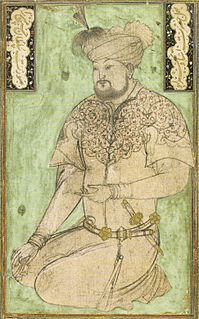Related Research Articles

Sultan Husayn Bayqara Mirza was the Timurid ruler of Herat from 1469 until May 4, 1506, with a brief interruption in 1470.
The Arghun dynasty was a dynasty of either Mongol, Turkic or Turco-Mongol ethnicity, who ruled over the area between southern Afghanistan, and the Sindh province Pakistan from the late 15th century to the early 16th century. The Arghuns claimed their descent and name from Ilkhanid-Mongol Arghun Khan. Arghun rule can be divided into two branches: the Arghun branch of Dhu'l-Nun Beg Arghun that ruled until 1554, and the Tarkhan branch of Muhammad 'Isa Tarkhan that ruled until 1591.
Shams al-Din is an Arabic personal name or title.
Shams al-Din 'Ali ibn Mas'ud ibn Khalaf ibn Mihraban was the first Mihrabanid malik of Sistan. He ruled from 1236 until his death.
Taj al-Din was the Mihrabanid malik of Sistan from 1346 until 1350. He was the son of Qutb al-Din Muhammad.
Qutb al-Din was the Mihrabanid malik of Sistan from 1380 until 1383. He was the son of Izz al-Din ibn Rukn al-Din Mahmud.
Nusrat al-Din Muhammad was the Mihrabanid malik of Sistan from 1318 until his death. He was the son of Nasir al-Din Muhammad.

The Mihrabanid dynasty was a Muslim dynasty that ruled Sistan from 1236 until the mid-16th century. It was the third indigenous Muslim dynasty of Sistan, having been preceded by the Saffarid and Nasrid dynasties.
Taj al-Din Shah-i Shahan Abu'l Fath or Shah-i-Shahan of Sistan was the Mihrabanid malik of Sistan from 1383 until his death. He was the son of Mas'ud Shihna.
Qutb al-Din Muhammad was the Mihrabanid malik of Sistan from 1403 until his death. He was the son of Shams al-Din Shah 'Ali.
Nasir al-Din Muhammad was the Mihrabanid malik of Sistan from 1261 until his death. He was the son of Mubariz al-Din Abu'l-Fath ibn Mas'ud.
Shams al-Din 'Ali was the Mihrabanid malik of Sistan from 1419 until his death. He was the son of Qutb al-Din Muhammad.
Nizam al-Din Yahya was the Mihrabanid malik of Sistan from 1438/1439 until his death. He was the son of Shams al-Din 'Ali.
Sultan Mahmud was the last Mihrabanid malik of Sistan, from c. 1495 until c. 1537.
Qutb ud-Din, Qutb ad-Din or Qutb al-Din is an Arabic male given name composed of the nouns Qutb and al-Din.
Muhammad Zaman Mirza (1496–1539) was a Timurid prince, and general to Mughal Emperors Babur and Humayun. He claimed himself as the ruler of Gujarat in 1537 but did not gain actual control.

Sultan Muhammad Mirza(Persian:سلطان محمد میرزا) was a Timurid prince and grandson of the Central Asian conqueror Timur by his third son Miran Shah. Little is known about his life, though through his son Sultan Abu Sa'id Mirza, he was the great-grandfather of Babur, The founder of the Mughal Empire of India.
Ḍiyaʾ al-Mulk Aḥmad ibn Niẓām al-Mulk, was a Persian vizier of the Seljuq Empire and then the Abbasid Caliphate. He was the son of Nizam al-Mulk, one of the most famous viziers of the Seljuq Empire.
Terken Khatun was the second/Third wife and chief consort of Malik Shah I, Sultan of the Seljuk Empire from 1072, until his death in 1092. She was born as a Karakhanid princess, the daughter of Tamghach Khan Ibrahim. She was the mother of Mahmud I, the next ruler of the Seljuk Empire, and regent during his minority in 1092–1094.
Nizam or Nezam is both a given name and a surname. It is derived from the Arabic word نِظَام niẓām, meaning "order, system", often by way of Persian. Notable people with the name include:
References
- Bosworth, C.E. The History of the Saffarids of Sistan and the Maliks of Nimruz (247/861 to 949/1542-3). Costa Mesa, California: Mazda Publishers, 1994.